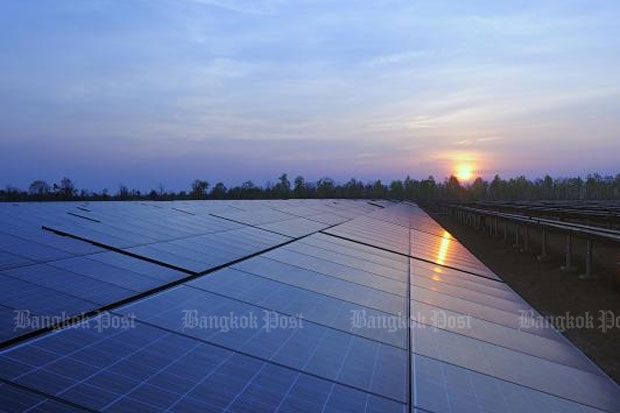
SET-listed SPCG Plc has joined forces with a Japanese solar module operator to build a 3-billion-baht, 30-megawatt solar farm in Japan, which is expected to go live in early 2017.
SPCG chairwoman and chief executive Wandee Khunchornyakong said the project will be undertaken by its joint venture with Kyocera Corporation, Japan’s leading solar module producer, and Century Tokyo Leasing Corporation (TCL), a Japanese leasing company.
The three partners hold equal stakes in the venture.
"Each company will invest around one-third of the investment value and Kyocera, who are experts in the sector and our strategic partner, will lead the project," said Ms Wandee.
She said Kyocera had already obtained the contract to sell electricity to the Japanese government for at least 20 years with a feed-in tariff (FIT) of 42 yen per kilowatt hour.
“Even though the cost of investing in a solar farm in Japan is higher than in Thailand, the price of electricity is also higher, so we see an opportunity to make a profit," said Ms Wandee.
She said the farm is located in a 700 rai space in Japan’s least populous Tottori prefecture and the area is currently being developed before construction gets underway.
This is SPCG's first investment project abroad, with which they aim to generate 30% of total revenue in the next three years, Ms Wandee said.
Japan has recently become a popular destination for Thai renewable energy operators looking to boost their renewable portfolios, though their investment plans are not really getting off of the ground.
"We often hear reports about Thai renewable investors interested in investing in Japan, but not many of them can actually do it," said Ms Wandee.
She said a lack of knowledge about Japanese rules and regulations on top of tough competition likely explained the failure.
"A local partner is a crucial element in pulling it off," Ms Wandee added.
Apart from the 30MW farm, Ms Wandee said two additional projects are in the works.
"We are in talks to develop two other solar farms in Japan. I'm sure that we can finalise the investment deal and also the power purchasing agreement within the second quarter of this year," she said.
She added that if the deal goes through, SPCG's capacity in Japan will total 100MW, though she could not provide any further details until it is completed.
SPCG has also been eyeing Asean member states including Myanmar and the Philippines, where it should be able to operate a combined capacity of 100MW. Ms Wandee believes those deals will be finalised in the second quarter of this year.
She said SPCG had set its revenue target at 5.5 billion baht and aims to double its solar farm capacity to 500MW in 2019 from the current level of 260MW.
Shoji Nishizawa, general manager of Solar Energy International Sales Division of the Japanese partner Kyocera Corporation, said Japan had faced power shortages since the 2011 Fukushima disaster.
“We have seen a lot of activity in the solar energy sector since the Japanese government set the nationwide goal of generating 54,000MW of power from solar by 2020," said Mr Nishizawa.
He said 10% of Kyocera Corporation revenue comes from solar-related activity. The company currently own solar farms in Japan generating around 200MW.
Mr Nishizawa said Kyocera had been a crucial partner of SPCG from the start and was keen on SPCG's participation in future investment opportunities.
Previously, Kyocera and SPCG partnered up to develop a solar farm in northeastern Thailand. With a total capacity of 257MW, it is the largest solar farm in Asean.
SPCG shares closed yesterday on the SET at 20.50 baht, up 20 satang, in trade worth 25 million baht.